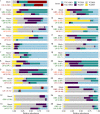Genotyping by sequencing for estimating relative abundances of diatom taxa in mock communities
- PMID: 36747145
- PMCID: PMC9903628
- DOI: 10.1186/s12862-023-02104-2
Genotyping by sequencing for estimating relative abundances of diatom taxa in mock communities
Abstract
Background: Diatoms are present in all waters and are highly sensitive to pollution gradients. Therefore, they are ideal bioindicators for water quality assessment. Current indices used in these applications are based on identifying diatom species and counting their abundances using traditional light microscopy. Several molecular techniques have been developed to help automate different steps of this process, but obtaining reliable estimates of diatom community composition and species abundance remains challenging.
Results: Here, we evaluated a recently developed quantification method based on Genotyping by Sequencing (GBS) for the first time in diatoms to estimate the relative abundances within a species complex. For this purpose, a reference database comprised of thousands of genomic DNA clusters was generated from cultures of Nitzschia palea. The sequencing reads from calibration and mock samples were mapped against this database for parallel quantification. We sequenced 25 mock diatom communities containing up to five taxa per sample in different abundances. Taxon abundances in these communities were also quantified by a diatom expert using manual counting of cells on light microscopic slides. The relative abundances of strains across mock samples were over- or under-estimated by the manual counting method, and a majority of mock samples had stronger correlations using GBS. Moreover, one previously recognized putative hybrid had the largest number of false positive detections demonstrating the limitation of the manual counting method when morphologically similar and/or phylogenetically close taxa are analyzed.
Conclusions: Our results suggest that GBS is a reliable method to estimate the relative abundances of the N. palea taxa analyzed in this study and outperformed traditional light microscopy in terms of accuracy. GBS provides increased taxonomic resolution compared to currently available quantitative molecular approaches, and it is more scalable in the number of species that can be analyzed in a single run. Hence, this is a significant step forward in developing automated, high-throughput molecular methods specifically designed for the quantification of [diatom] communities for freshwater quality assessments.
Keywords: Diatoms; GBS; Mock communities; Quantification; Relative abundance; Water quality assessment.
© 2023. The Author(s).
Conflict of interest statement
The authors declare that they have no competing interests.
Figures


Similar articles
-
Genetic barcoding of Ecuadorian epilithic diatom species suitable as water quality bioindicators.C R Biol. 2020 Jun 5;343(1):41-52. doi: 10.5802/crbiol.2. C R Biol. 2020. PMID: 32720487
-
Next-generation sequencing to inventory taxonomic diversity in eukaryotic communities: a test for freshwater diatoms.Mol Ecol Resour. 2013 Jul;13(4):607-19. doi: 10.1111/1755-0998.12105. Epub 2013 Apr 17. Mol Ecol Resour. 2013. PMID: 23590277
-
Environmental Monitoring: Inferring the Diatom Index from Next-Generation Sequencing Data.Environ Sci Technol. 2015 Jul 7;49(13):7597-605. doi: 10.1021/es506158m. Epub 2015 Jun 18. Environ Sci Technol. 2015. PMID: 26052741
-
The ecology of the planktonic diatom Cyclotella and its implications for global environmental change studies.Biol Rev Camb Philos Soc. 2015 May;90(2):522-41. doi: 10.1111/brv.12120. Epub 2014 Jun 11. Biol Rev Camb Philos Soc. 2015. PMID: 24917134 Review.
-
Diatoms as indicators in running waters: trends of studies on biological assessment and monitoring.Environ Monit Assess. 2022 Aug 19;194(10):695. doi: 10.1007/s10661-022-10383-3. Environ Monit Assess. 2022. PMID: 35986195 Review.
Cited by
-
Comparing the precision of two digital PCR applications for copy number comparisons in protists.Sci Rep. 2025 Jul 25;15(1):27095. doi: 10.1038/s41598-025-13143-8. Sci Rep. 2025. PMID: 40715338 Free PMC article.
References
-
- Directive 2000/60/EC. Water framework directive of the European parliament and the council, of 23 October 2000, establishing a framework for community action in the field of water policy. Off J Eur Commun. 2000; L327, 1–72.
-
- Sabater S, Guasch H, Ricart M, Romaní A, Vidal G, Klünder C, Schmitt-Jansen M. Monitoring the effect of chemicals on biological communities. The biofilm as an interface. Anal Bioanal Chem. 2007;387(4):1425–1434. - PubMed
-
- Benfield M, Grosjean P, Culverhouse P, Irigolen X, Sieracki M, Lopez-Urrutia A, Dam HG, Hu Q, Davis CS, Hansen A, Pilkskaln CH, Riseman EM, Schultz H, Utgoff PE, Gorsky G. RAPID: research on automated plankton identification. Oceanog. 2007;20(2):172–187.
-
- Hering D, Johnson RK, Kramm S, Schmutz S, Szoskiewicz K, Verdonschot PFM. Assessment of European streams with diatoms, macrophytes, macroinvertebrates and fish: a comparative metric-based analysis of organism response to stress. Freshwater Biol. 2006;51(9):1757–1785.
-
- Grosjean P, Picheral M, Warembourg C, Gorsky G. Enumeration, measurement, and identification of net zooplankton samples using the ZOOSCAN digital imaging system. ICES J Mar Sci. 2004;61(4):518–525.
Publication types
MeSH terms
Substances
Grants and funding
LinkOut - more resources
Full Text Sources
